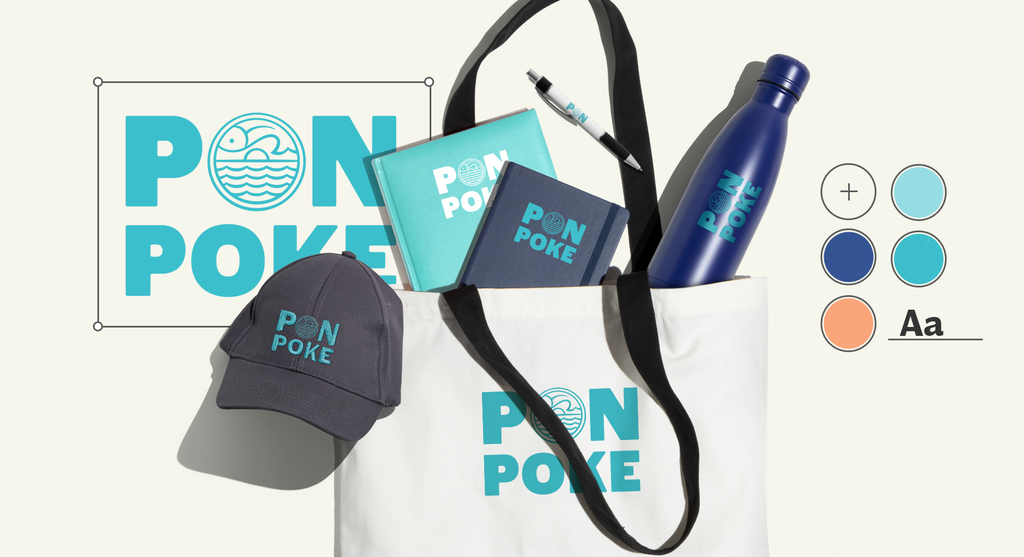While branding is a broad concept and it may seem daunting, understanding it is key to a successful business—especially for small business growth. That’s why we’re here to break it down for you. Not just in terms of what branding means, but how to apply the elements of good branding to your own company.
So what is branding? You might think of your product as your brand, but in marketing terms, they’re two different things. Your product is what you sell, whether it’s something physical or a service. There are likely similar products on the market. But your brand should be unique. It’s what gives your business its personality, what helps customers remember you and what shapes their experience, both online and offline.
To learn more about the meaning of branding and its role in marketing—read on! We’ll explore how modern branding works in a digital-first world and how you can build a strong, consistent identity for your small business.
- Branding is the complete perception customers have of your business across every touchpoint.
- A strong brand helps small businesses build trust, attract loyal customers and stand out from competitors.
- Your brand identity includes visual elements like your logo and colours, your voice and the experience customers have with your business.
- Branding extends to social media, websites and online reviews, making consistency more important than ever if your brand has a strong online presence.
- Measuring branding success means tracking customer awareness, perception and loyalty through tools like surveys, social listening and Net Promoter Scores.
What is branding?
Branding is the overarching idea or image associated with your company and product. It’s how people recognize and emotionally connect with your business online, in person or anywhere your brand appears.
Your name, logo, designs and unique features of your company’s personality are all part of your brand. Your brand identity appears on and around your product, setting it apart from other products in the market. But branding also includes less tangible elements like your tone of voice, customer experience and social media presence. These communicate what your business stands for and why people should choose you.
A well-developed brand will trigger emotional cues in your audience that lead them to favor your brand over others. Different audiences want different things, and you’ll find that numerous brands selling almost exactly the same things will have found a way to differentiate their brand to attract specific people to buy their products instead of competitors. People buy from the brand that resonates with them most.

How does branding work for small businesses?
For small business owners, this differentiation often comes from authenticity and storytelling. In fact, a benefit for SMBs is the ability to share your purpose, values and craft in a way big corporations can’t easily replicate.
For example local coffee roasters could all offer similar products, but their branding—whether it’s minimalist design, eco-friendly packaging or a community-focused story—tells customers why they should care about that brand in particular. That emotional clarity turns a simple product into a memorable brand that consumers can relate to.
Modern branding also applies across digital channels. Your website design, email templates and social media all reinforce who you are and build brand recognition over time.
When your visual and verbal identity stay consistent, your brand feels stronger and more trustworthy to audiences.

How to create your brand
At its core, a brand is influenced most by how it is perceived by audiences. It’s all very well thinking that your brand is the most scientific and fact-based on the market. But if consumers consider your brand to be inauthentic and less factually informed than your competitors then it might be time to consider your positioning.
Remember that your brand lives in the minds of your customers, and their experiences and feelings define it just as much as your design or messaging. This is why brand research, which includes asking existing and potential audiences how they perceive your brand, plays a key role in brand development.
Brand development for small businesses
You’ll probably have noticed for yourself how some brands seem to boom or fade away depending on how the public perceives their image. It’s the same thing that happens with celebrities or TV shows: as soon as the feeling toward you and your brand changes, your popularity can rise or fall in an instant.
For this reason, it’s important to be transparent, consistent and reflective. For small business owners, this means checking in regularly with customers through surveys, reviews or social media engagement to see how your brand reputation is evolving.
You’ll want to ask questions like, “What associations do people make with your brand?” Then consider, are they the associations you’re happy with, or would you prefer for your brand to be perceived differently? If you’re not happy with your current perception, why is that? If it’s because it doesn’t accurately reflect your brand, what can you do to change that? These are just some of the factors that will help you develop your brand.
A good exercise is to define three words you want people to associate with your business and then test whether your current visuals, tone of voice and customer experience actually support them.
How customers can help build your brand
There will be external elements, like reviews and word-of-mouth, that are out of your control. They could be positive or they could be negative, but they will influence the perception of your brand.
That’s why it’s so important to have a full and comprehensive understanding of your intentional branding—so that you can actively promote the messaging you want audiences to associate with you. This also includes managing your digital presence, from your Google Business profile to your social media channels, so that every touchpoint reflects your brand accurately.
It begins with defining your product. When you know exactly what problem your brand solves, who you serve and why your story matters, you’ll have the foundation to develop a brand that feels authentic and resilient no matter how trends or markets change.

Defining your product
If a brand can be defined by associations and perceptions, then the product can be defined as the specific output of that brand. The product, as well as the company itself, will benefit from the associations that the brand makes, helping the business to become both trusted and distinctive. In other words, branding adds perceived value. It’s what turns a simple item or service into something people recognize and are willing to pay more for.
Your brand marketing, company culture, advertising and design all influence how well your brand performs. Plus they can all influence how well your product performs on the market. So, use your brand to define your product—like unique brand fonts, company colors and slogans—to boost its performance, and it can even lead consumers to pay more for it than for others they don’t view as premium.
How small businesses can define their branding
For small businesses, these visual and verbal choices work together to create consistency, from your packaging to custom apparel and website design. The more cohesive your identity feels, the easier it is for customers to trust and remember you.
For example, a local bakery that invests in branded packaging and signage will be associated with quality and freshness as customers notice the consistency of their branding. As a result, the bakery’s products may start to feel more premium without needing to raise prices significantly. That’s the power of branding in action.
Your product tells part of your story, but your branding brings the story to life. When customers see the same tone, colors and personality reflected across your marketing and materials, it reinforces who you are and what you stand for—making your business more memorable over time.

4 key questions to shape a strong brand
Branding is a vast and often vague area of marketing, and it’s easy to feel overwhelmed by your brand’s persona, messaging, design and everything else that falls under the branding umbrella. From your logo to your social media tone, every choice shapes how people experience your business. So to help simplify branding, we’ll focus on the four key elements that will kickstart your branding strategy. These essentials apply whether you’re building your first small business brand or refreshing one that’s already established.
1. Do you understand your brand?
Whether you’re launching a brand, reassessing an existing brand or repositioning your brand to target a different niche, understanding who you are and how that fits in with your audience’s needs is vital.
What do you offer? How is it different? Why are you doing it? How can it best be presented to appeal to its target audience? These questions can apply to any business, in any industry. And they’re the cornerstone to understanding your brand.
You can start by writing a short brand statement. It can just be a few sentences that describe what you do, who you serve and what makes your business unique. This helps align your team and gives you a clear framework for all future design and marketing decisions.
Once your brand is out there, it immediately becomes the face of your product and consumers will begin to build their associations with it. So it should be consistent across your product, your advertising and all of your communications. That consistency builds familiarity, and familiarity builds trust.

2. What’s your vision?
Your brand’s vision isn’t just about your proposition and how you see the world (although that does come into it). It’s about the future of your brand, and how you fit into people’s lives in the long term. It could be as simple as adapting to meet new and unprecedented needs, or it could be about tackling practical issues to offer your product in a totally new way.
Whatever your vision for the future, you should be clear on the end goal so you can set up systems to help you achieve it. A strong vision helps guide everything from design decisions to customer experience, and it should be easy for your audience to understand in a single sentence.
For small businesses, your vision could be about creating eco-friendly home goods that last longer, helping your community to shop local or offering a service that makes life easier for busy parents. The point is to connect your purpose to your customers’ values. When your team and audience understand that bigger “why,” every part of your brand, from your visuals to your tone, feels more meaningful.
Consider writing a short vision statement that feels aspirational but achievable. For example: “To make sustainable self-care accessible to everyone,” or “To add a touch of local creativity to every doorstep.” This gives direction to your brand growth and helps you decide which opportunities to pursue and which to let go.

3. What values do you hold?
Creating a set of values that’s completely unique to your brand can be challenging. According to WorkVivo, the majority of businesses share the same ten values: quality, openness, innovation, individual responsibility, fairness, respect for the individual, empowerment, passion, flexibility, teamwork and pride.
That’s why the communication of your brand values is just as important than the values themselves. What matters is how those values show up in your daily actions, from how you design your packaging to how you respond to a customer review.
For example, if sustainability is one of your core values, then the ways in which you explicitly and implicitly communicate that to your audience will impact the way they view your brand. If you’re a clothing brand pushing sustainability messaging, and it turns out your supply chain isn’t so ethical, then your brand’s value will seem as disingenuous as a multi-billion dollar oil firm claiming eco-friendly values.
It’s important to pick genuine values that can be authentically supported by your brand’s mission and practices, and communicate them in a natural way. For small business owners, that could mean showing transparency about where your products come from, supporting other local businesses or giving back to your community. These are tangible, relatable ways to make values visible without sounding performative.
An example might be a local café that promotes sustainability not just through words but through compostable cups, partnerships with nearby farms, transparency about their coffee suppliers and social posts highlighting their waste reduction. Those consistent, authentic actions make the value of “sustainability” feel real rather than rehearsed.

4. What’s your personality like?
Your brand’s personality comes down to the tone, design and language you use to present your brand externally and internally. It could be expert and professional, playful and humorous or relaxed and friendly. Your brand personality is essentially how your business sounds and feels to your customers. It shapes every interaction, starting with your logo and color palette through to your social media captions and customer emails.
Think about how your personality can appeal to the kinds of people that make up your target audience. It should be almost like another person that they would be able to relate to in real life. It doesn’t need to be reflective of the personalities within your business, but hiring employees that fit the persona will help to influence all your outward communications in a more natural way. If your brand feels approachable, customers will be more likely to engage with you, and if it feels confident and consistent, they’ll be more likely to trust you.
A good way to define your personality is by choosing three adjectives that describe your tone, then applying them across all platforms. For example: “friendly, clever and down-to-earth” or “bold, minimal and professional.” Make sure this personality also shows up visually in your brand identity so that what people see matches what they hear.
These four brand pillars—understanding, vision, values and personality—form the foundation of your brand. They also help you understand how it can be used to appeal to certain types of people.
When your brand pillars align, they help you connect authentically with your audience and make communication feel intentional and consistent.

How modern markets have changed branding
Over the past decade, a revolution in digital communication has transformed the world of marketing. It has introduced new platforms, formats and behaviors that have completely redefined how brands connect with customers.
From customer reviews to near-instantaneous expectations of customer service, social media (and the internet as a whole) have also increased the voice of audiences and their power to influence both your business and other consumers. One viral video or one poor review can shape a brand’s reputation overnight.
It’s also given rise to new brands that are better equipped to navigate the modern, digital landscape than other, bigger brands that remain stuck in the past. For small businesses, this shift levels the playing field. Social media and e-commerce tools make it possible to build strong brand awareness without a huge advertising budget. Even personal brands like creators, consultants and local entrepreneurs can grow loyal followings through authentic storytelling and consistent visual identity.
What is branding in today’s market?
Now, consumers are more interested in what other consumers have to say about brands, rather than what brands say about themselves. That means your customer experience, online reviews and social engagement now speak louder than any paid ad. This puts pressure on brands to deliver on their values and visions.
In the era of TikTok, Google Reviews and Trustpilot, brands are expected to be transparent, responsive and human.
AI and personalization have also added new opportunities and challenges. Small business owners can now use AI tools to customize their brand visuals, content and customer interactions at scale. But with that convenience comes a greater need for authenticity. The more technology shapes communication, the more important it becomes for your brand to sound human and stay true to its values.
Modern branding isn’t just about visibility. It’s also about credibility, and brands that can listen, adapt and communicate with honesty will continue to build trust in an increasingly AI-driven world.
Branding for different industries
Many of the rules of branding apply to all businesses regardless of industry or sector. However there are some elements, like the values you choose to amplify, that will be more relevant for some industries than others.
Similarly, the type of business you’re running will have an influence over your branding and how you choose to communicate with different audiences. What matters most is how you translate those shared branding principles into something that fits your market.
1. Startups
Starting a new business comes with its challenges. The upside is that you get to assess the existing landscape and find the niche where your company slots in. You can review the existing brands and where you think they’re getting it right and wrong.
It’s up to you to decide how your brand can speak to a specific audience in a way that’s better and more engaging than the competition. Startups also have the advantage of agility. You can test new ideas quickly, pivot your message and experiment with your visual identity without the weight of legacy perception.
As well as the power to adapt, start-up brands can be bold with their ambition. Nobody has any expectations or associations with your brand yet, so if you say you’re empowering or premium or people-focused then audiences will be more inclined to believe you. That early flexibility is your opportunity to make a strong first impression. A clear visual identity, consistent brand voice and a confident story will help you build recognition faster, even with a smaller budget.

2. B2B
How your brand is perceived isn’t only important for consumer-facing companies. Business-to-business brands still need to market their product in the same way, just to a different kind of consumer. The principles of branding are still just as relevant, since the person deciding whether or not your business is the right fit for theirs is susceptible to the same associations and preferences as a regular consumer.
In these instances, it might be more useful for your brand to frame itself as professional and expert rather than friendly and humorous. That means focusing on trust, credibility and clarity, especially online. However, you’ll still need to find your market niche to appeal to companies you’d want to work with. A strong B2B brand should demonstrate its expertise through case studies, testimonials and clear visual consistency across presentations and your website.
3. Public sector businesses
Branding for public sector organizations is more focused on public image and brand management. For example, a council, government agency or police force doesn’t need to attract sales like commercial brands do. But they need their audience to understand who they are, what they do and what they stand for. In this context, branding supports trust, transparency and community connection.
Although public sector organizations should always have clear branding in the form of a slogan, logo and design details like fonts and colors that are instantly recognizable, a lot of managing public brand perception comes down to campaigns. So if a police force were running a campaign to crack down on a certain type of offense and they wanted to raise public awareness and support, that campaign would have to clearly include all their existing branding alongside strong messaging about their values and vision.
The same applies to local initiatives, public health programs or sustainability projects. When visuals and messages are consistent, the public is more likely to recognize the organization and engage with its goals. Digital platforms also play a huge role as websites, newsletters and social media updates all help reinforce your transparency and reliability.

4. Services as a product
If customer service is a big part of your business—for example, if your offering is a service like insurance, or you have brick-and-mortar stores with service staff like a bank or a grocery store—then your brand needs to extend to how your service is provided. Every customer interaction becomes a brand touchpoint, influencing how people feel about your business after the transaction is over.
For instance, if your brand is proud of its laid-back and friendly persona then your service staff should match this rather than being overly professional and serious, and vice versa. Similarly, if you talk about the top-quality service your brand provides, then all service staff should be highly trained in how to provide this to customers. Even small details—like greeting customers by name or wearing branded uniforms—can reinforce your identity and help your business feel more cohesive.
In this kind of industry, many brands find it useful to hire employees with experience in customer service over those with experience in the specific field of business. Once they’re with your brand, employees can pick up the details of what you do. But delivering a great service is harder to teach to those who might not feel adept at being the face of a brand.

How to build and communicate your brand identity
So you’ve developed your brand. Now you need to know how your audience and potential new customers understand what you’re all about. They’re going to need to understand how you’re different from your competitors, and they’re going to want to know that you’re credible before they switch alliances.
That’s where brand communication comes in. Make sure every touchpoint, from your packaging to your social media, consistently tells the same story about who you are and why you matter.
Storytelling as marketing
One of the best brand marketing techniques for getting brand image across to the public is storytelling. You can tell your story with a logo or slogan that represents what you do. You could pick brand colors that have cultural connections, for example, green for fresh or environmentally-friendly goods.
Use your website and other platforms to tell your story—literally. This doesn’t have to mean writing long mission statements. Often, it’s the small visual cues and consistent tone that communicate your identity best.
Storytelling as a small business
For small businesses, storytelling can be as simple as showing the human side of your work. A local designer might share behind-the-scenes photos of the creative process, a restaurant could post about where its ingredients come from or a florist might share customer events featuring their arrangements. These stories build emotional connections and make your brand feel more personal and authentic.
Storytelling shouldn’t just be about the background of your business, but how everything you do feeds into your brand’s—and your customer’s—values. Here are some tips to tell your small business’ brand story in 3 easy steps.
This kind of storytelling is also a powerful way to build your brand’s credibility. Reviews are one of the most trusted sources of information that customers look to before making a purchase. By being upfront about the quality of your product and service, you show confidence in what you offer.
Display testimonials or customer photos on your website and social channels, and invite feedback through platforms like Google or Yelp. Honest, visible reviews can strengthen consumer trust and help new customers feel confident choosing your business.

Engaging customers with your brand
How you communicate with your end-user is one of the easiest ways you can differentiate from other brands in the same industry. Finding ways in which you’re able to stand out from the crowd—like a strong, relatable tone of voice—will engage customers and keep them interested in what you’re doing. Your voice should feel authentic and consistent across every platform, whether it’s your website, social media, emails or packaging.
Small businesses often do this best because they can connect directly with their audience in a genuine, human way. Maybe that’s a boutique using playful Instagram captions, a café sending conversational newsletters or a home service company sharing useful tips on TikTok. These personal touches build familiarity and make your brand feel approachable.
But remember, engagement isn’t only about talking—it’s about listening, too. Ask your customers questions, respond to their comments and use their feedback to improve what you offer. That two-way communication helps customers feel seen and valued, turning them into long-term advocates for your brand.

Refreshing your branding
No matter how long your brand has been around or how well-established you are, keeping your branding fresh and relevant is vital. You’ll have noticed many big brands change their logos, color schemes and messaging as the years go by, and if you’ve ever wondered why, this is the reason.
It’s not about completely overhauling what they do but rather adapting their brand to fit the way their service, values and vision have evolved over time.
Refreshing your small business
Even for small businesses, a brand refresh helps you stay relevant and connected to your audience. A simple update like refining your logo, updating your color palette or modernizing your website can signal growth and remind customers that your business is active and evolving. The goal isn’t to start from scratch but to reflect how your story, customers and market have changed.
Refreshing your brand’s name
Another major element of branding that you might decide needs a refresh is your name. Of course, changing a company name isn’t a decision that should be made lightly. But if your vision, values and service have changed so greatly over time that your old name no longer represents who you are or what you do—or has developed deep associations with something that your brand no longer relates to—then it might be a plausible option.
In a market that’s saturated with so many competing brands, picking a name should come down to ease of understanding. It should represent exactly what your brand does without feeling confusing or hard to remember. After all, if your competitor’s name is easier to say or spell, it’s more likely to be front of mind when consumers come to need that product.
Check out more tips for choosing the right business name idea.
Branding and design
Design plays a major role in your brand’s identity. It’s the top level of your branding that many people will see before they even know what it is or who you are. Your brand design is the connecting factor between your less tangible brand motives, and how you communicate them with your audience.
Branding and your logo
Think of some of the biggest brands in the world—McDonald’s, Nike, Apple—and their logos spring to mind almost simultaneously when we hear their names. That immediate recognition shows the power of design to make your business feel familiar, trustworthy and professional. So while the deeper levels of your branding strategy are what will attract and retain your audience, your logo is the element that has the power to stick in people’s minds.

Source: Design by Aleksa via 99designs by Vista.
Branding design elements: Your brand book
However, your brand logo isn’t the only identifiable design element that your brand should focus on. Every visual detail works together to shape the experience people have with your business.
In developing a brand book—a document of all the design themes for your brand—for all designers across your company to use, you should also consider the following branding elements:
- Colors: Choose shades that reflect your brand’s tone and emotion (for example, soft neutrals for calmness or bold brights for creativity.)
- Shapes: Do you want to appear modern and sleek or friendly and approachable? Rounded shapes can feel welcoming, while sharp angles communicate precision and confidence.
- Typography: Select fonts that mirror your personality, like clean sans-serifs for simplicity, bold type for energy or script fonts for warmth.
- Values: How can your design represent what you stand for, for example eco-conscious materials or minimalist packaging to reflect sustainability.
- Sounds: If your brand uses video or audio, consider elements like music, voiceover tone or animation style to make your brand instantly recognizable.
Once you’ve settled on how each of these branding elements will look, feel, and sound for your brand you can ensure that they’re implemented across all your marketing and communications. Your brand guidelines can also include your verbal and personal brand instructions, as touched on in our section on service companies.
Measuring your brand’s success
Once your brand is up and running, it’s important to know whether it’s working the way you intended. Branding is measurable, and tracking how people recognize, remember and feel about your business helps you understand what’s resonating and where you can improve.
Here are a few simple ways to measure your brand’s performance:
Brand awareness
Track how many people recognize your business name or logo. You can measure this through surveys, social listening tools or website traffic from branded search terms.
Brand perception
Ask customers what comes to mind when they think of your business. Short polls or post-purchase surveys can reveal whether your brand feels trustworthy, affordable or premium.
Customer loyalty
Repeat purchases, referral rates and reviews are key metrics that show how your brand experience matches your promises.
Engagement metrics
Monitor likes, shares, comments and mentions on social media to see which messages connect best with your audience.
Consistency checks
Regularly review your website, packaging and custom apparel to check that your visuals, tone and messaging are aligned with your brand guidelines.
Schedule a quick brand audit every six months. Feedback forms or Google Analytics can show you how your brand is growing and whether your story still reflects your customers’ needs.
Bringing your branding to life
Once you’ve understood the difference between your brand and your product, defined your idea and mapped out your vision, values and persona, you’re well on the way to owning your unique brand. It should talk directly to your target audience and feel more relatable to them than the competition. Importantly, it should also fit a market niche based on quality, tone of voice, service or any other aspect of your brand that you feel sets it apart.
Your values and vision should be instilled in your team so that your company culture embodies what the brand stands for. This will enable your brand to present itself more effectively and authentically. And don’t forget that your branding should inform the way you communicate across every platform. From your social media captions to your packaging design, every detail should reflect who you are and what you stand for. Your messaging and design should always be consistent to ensure continuity.
Building a strong brand comes down to clarity, consistency and connection. When you understand your brand inside and out (and know when to evolve it), you’ll have a foundation that grows with your business. If you’re ready to dive into branding, check out our ultimate guide to branding—full of tips for entrepreneurs.
